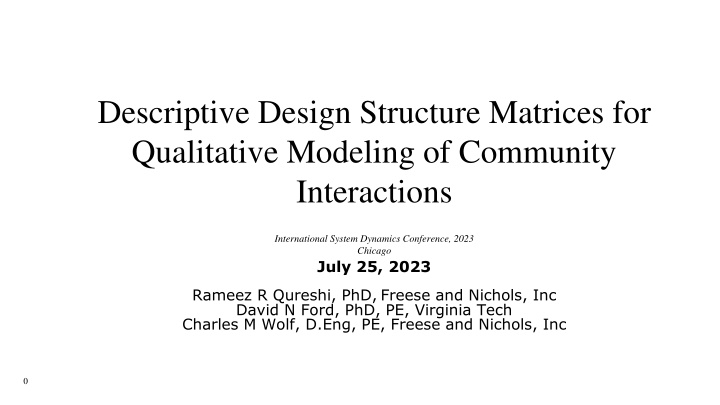
Qualitative Modeling for Community Interactions in System Dynamics
Explore how qualitative modeling techniques can effectively represent complex community interactions in system dynamics, addressing challenges in system analysis and formal modeling. Discover solutions to represent various system components and interactions for an enhanced system overview.
Download Presentation

Please find below an Image/Link to download the presentation.
The content on the website is provided AS IS for your information and personal use only. It may not be sold, licensed, or shared on other websites without obtaining consent from the author. If you encounter any issues during the download, it is possible that the publisher has removed the file from their server.
You are allowed to download the files provided on this website for personal or commercial use, subject to the condition that they are used lawfully. All files are the property of their respective owners.
The content on the website is provided AS IS for your information and personal use only. It may not be sold, licensed, or shared on other websites without obtaining consent from the author.
E N D
Presentation Transcript
Descriptive Design Structure Matrices for Qualitative Modeling of Community Interactions International System Dynamics Conference, 2023 Chicago July 25, 2023 Rameez R Qureshi, PhD, Freese and Nichols, Inc David N Ford, PhD, PE, Virginia Tech Charles M Wolf, D.Eng, PE, Freese and Nichols, Inc 0
Context 1 Representing systems with many system components and many interactions can lead to congested CLDs For example, consider a community recovering from natural disasters, *For simplification purposes, CLD shows the interaction only between Housing and Construction sector BUT ITS NOT JUST HOUSING AND CONSTRUCTION DDSM Structure A Solution The Challenge Results Application
NOT Only Housing and Construction! 2 Representing systems with many system components can lead to congested CLDs For houses to be made available for occupancy, there are other sector services that need to be made available, for example, power supply. For construction services to be made available, there need to be physical facilities required for construction (staging area, office space, etc.), social infrastructure (construction firms), and a workforce. How can system dynamicists identify, map, and model large tightly coupled systems? DDSM Structure A Solution The Challenge Results Application
Qualitative Modeling of Interactions 3 A qualitative tool is useful in SD to bridge the gap between the system and the modeler if it facilitates : Modeler communication with non-technical system participants Modeler communication with technical system participants System Analysis, and Formal modeling DDSM Structure A Solution The Challenge Results Application
Background: Design Structure Matrix (DSM) 4 Clear Practical Scalable Proven DDSM Structure A Solution The Challenge Results Application
Descriptive DSM Conceptualization 5 4 parallel 2-dimensional DSMs were developed to allow information representation in multiple forms Binary/Traditional DSM How would you visualize components and interactions for system overview? Non-Technical DSM How would you describe interactions to non-technical people? Technical DSM How would you describe the interactions to the city department heads? Source DSM What is the source that supports the reported interactions? DDSM Structure A Solution The Challenge Results Application
6 DDSM in Action: Case-Study Background JTFRP Project Status as of March 2019 90% 80% 80% 70% 60% 50% 40% 30% 20% 10% 10% 0% 2019 Planned % Spending Actual % Spending DDSM Structure A Solution The Challenge Results Application
7 Identify System Components What built-infrastructure is required for the recovery of Kashmir? Community Recovery is defined as the restoration of normal patterns of community activities as they existed in the pre-disaster period. (Lindell 2006) Identified 16 Community Infrastructure Systems relevant to recovery in Kashmir used as inputs for rows and columns in the DDSM DDSM Structure A Solution The Challenge Results Application
8 Identify System Component Interactions Use system information to identify which system components interact DDSM Structure A Solution The Challenge Results Application
Binary Community Recovery DDSM 9 Clear Practical Scalable DDSM Structure A Solution The Challenge Results Application
10 System Description Using DDSM Non-Technical DDSM How would you describe interactions to non-technical people? Practical Scalable Level 1 Community Recovery DDSM for non-technical managers (*Representative image) DDSM Structure A Solution The Challenge Results Application
11 System Description Using DDSM Technical DDSM - How would you describe the interactions to the domain experts? Practical Scalable Level 2 Community Recovery DDSM for technical managers (*Representative image) DDSM Structure A Solution The Challenge Results Application
12 DDSM in Action: Case-Study Analysis Clear Practical Scalable Proven Recovery Manager s Mental Model Actual Recovery Matrix DDSM Structure A Solution The Challenge Results Application
Example Integration of DDSM and SD Models Capacity of an infrastructure at any time is a function of Dependencies among infrastructure systems (Loop R1) Available workforce (Loop R2) Available physical infrastructure (Loop B1) Legend of Loops: R1: Sector Operations Growth Loop R2: Workforce Growth Loop B1: Population Goal Seeking Loop Feedback Structure of Community Growth DDSM Structure A Solution The Challenge Results Application
Example Identification of Feedback Loops 14 Scalable Practical DDSM Structure A Solution The Challenge Results Application
Contributions Improves qualitative system dynamics modeling of large tightly coupled systems by helping modelers to: Identify and structure system information Collect and use rich system structure information in modeling Identify feedback loops Qualitatively identify and explain system interactions and their impacts on system behavior and performance Bridge gaps between the system being modeled and the formal simulation model DDSM Structure A Solution The Challenge Results Application
Modeling Community Interactions Using Descriptive Design Structure Matrix (DDSM) 16 Clear Practical Scalable Proven DDSM Structure A Solution The Challenge Results Application
THANK YOU! "In the midst of chaos, there is also opportunity." - Sun Tzu
